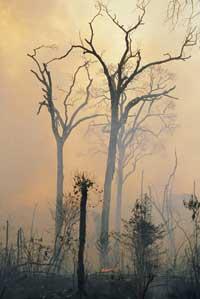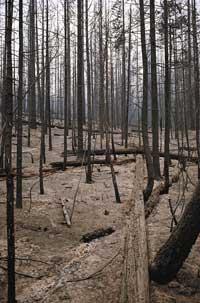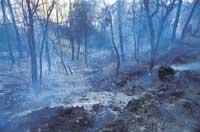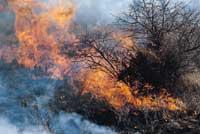With the desire to smoke?

Thin smoke, jet of pine resin and improvised spark; when detecting any sign of campfire, all forest animals escape as soon as possible. However, if we look at them, we can see animals circulating in the opposite direction. Fire is an unbearable force of attraction for Melanophila beetles approaching from afar. The females arrive grouped to copulate in the ‘sweetness’ of the fire and, as the fire calms, lay the eggs under the surface of calcined trees.
The ability to locate a remote fire for beetles is part of your survival strategy. Healthy trees are plagued with defenses against phytophagous beetle larvae and it is hard to live by the neck of healthy pines. Therefore, insects that feed on wood generally prefer diseased or suffering trees, with their defenses reduced. And, optionally, the newly dead trees are very appropriate. It has also been said that they are able to travel 80 kilometers to reach the fire. But how can an insect so far from so few centimeters detect fire?
For more than a century biologists have not been able to answer this question. In recent years, however, German researchers could know the secret of the beetle. These detectors, unparalleled in nature, begin to pay attention even in a seemingly unexpected place: In the U.S. Air Force (look for ways to find better heat tracks).
It was evident that these insects were very sensitive to some sign emitted by the burning trees. According to the researchers, beetles collect the first signs of fire from small chemical residues found in the dispersed smell of smoke produced by wood. But to locate the fire two very sensitive infrared detectors are used to capture the radiation emitted by forest fires.
Forest fires produce smoke mists and pines are especially noisy when burned, as their resin is extremely flammable. However, experiments suggest that beetles did not fly to the origin of smoke, nor did they seem to respond to the sound of fire or visible light.
But fires, in addition to visible light, produce infrared light, and it seems that infrared radiation is an excellent instruction. Most of the infrared produced by the heat of the wood fire is wavelength between 2 and 4 micrometers and, in addition, propagates well through the atmosphere (shorter or longer wavelengths absorb water vapors from the air).

Researchers also found additional organs called “perforated organs” in the central ‘axils’ of beetles. Since beetles fly by lifting the central legs, these organs are very willing to receive infrared signals.
In the 1960s, Canadian entomologist William Evans observed that beetles waved an antenna if they directed the infrared light beam to the perforated organ. Nothing happened directing the ray to any other place in the body. He also observed that the most violent reaction was caused by an infrared light wave of 3 micrometers in length and concluded that the perforated organs were a type of infrared detectors.
For thirty years, however, the theory was accepted but not demonstrated. Finally, Schmitz and his colleague Horst Bleckmann decided to investigate the potential of Melanophila acuminata, a kind of cocoa. To do this, after a forest fire in northern Berlin, they collected the calcined wood full of larvae and waited for the males to become beetles. They were fed in the laboratory and prepared for the fire search test.
Result? M. acuminata lines or holes are filled with dozens of fine but high-efficiency infrared sensors (see image above). Each sensor is able to capture the wavelengths of the infrared emitted by the flames of forest fires. However, the perforated organs of Melanophila seem to act in some mechanical way.
Structure
Each perforated organ is filled with 70 small and rounded. These sensors, or sensitive, are located at the bottom of the line and stand out for their thin soft cuticle coating. Each sensitive is a sphere that hangs from the short cut to the cuticle (see diagram), made with a softer and more flexible smear. Tucked into a small groove at the bottom of the sphere, is the mutit of the cellular cell of sensory sensitive nerves.

In the laboratory, placing individual sensils in infrared radiation of the same wavelength as forest fires and placing them at an infrared radiation of 24 milliwatts per square centimeter for 2 milliseconds (about twice as much as your hand emits) is enough to trigger the succession of signals from the nerve cell at the base of the sphere. But the radiation of 5 mili watts (the lowest intensity that could be achieved with their devices) also caused a brief response.
Mechanism
But how do pierced organs get so much sensitivity? Research groups saw that sentsilis also respond to touch. In his opinion, the sensor is ‘photomechanical’, so never before seen in nature. Somehow, the radiation that arrives becomes a mechanical force capable of generating a certain pressure in the inferior nerve cell and being able to trigger the impulse.
With the help of physicists they create a theory that explains their functioning. The key is in the sphere. The dial is a fairly large 15 micrometer diameter ball, optimally positioned to absorb infrared radiation. Most chemical bonds of organic molecules absorb infrared light, but the endocuticle has numerous bonds that absorb wavelength light of 3 micrometers (the largest wavelength emitted in forest fires).
The infrared of this wavelength vibrate more strongly the links and that energy quickly becomes heat. For the approximate calculation, a sphere of the same hardness as the endocuticle of the insect spheres was made by rubber or resin, which has been placed in an infrared of 5 milliwatts. The temperature of the artificial sphere rises approximately 0.01 °C. This small change would be enough to extend the sphere and push the nerve cell end down and thus deform the nanometer of the outer cell membrane.
Distance

With a quick calculation, beetles should detect 10 hectares of fire at a distance of 12 kilometers. But that would be almost certain to despise the ability of beetles. If the researchers' instruments had the ability to generate lower intensity infrared, it is believed that with 500 microwatts they could also initiate the nervous impulse. The numerous sensitive beetles may help overcome environmental noise and may even receive weaker infrared. And it may be enough to explain the observed journeys of 80 kilometers or more.
So what do beetles have to do is just wait for the infrared ‘starting signal’ and start a race to find a copulation buddy around the fire? No! The beetles that inhabit between the leaves of the trees have difficult to feel the warmth of any infrared in their perforated organs, so the signal would be lost, both between hills, branches and branches, and between the legs of the beetle itself. The only possibility to detect infrared radiation in the flames is to fly above the trees, lift the central legs and start looking. This is why beetles also need smoke detectors. Consider that to start it they need some abrasive and that the trigger would be a scent mark of roasted pine.
Researchers have found that M. acuminata, apparently on the antenna, has sensitive odour receptors, although it is not yet known where it has them exactly. Smoke detectors are sensitive to many volatile chemical components produced in forest fires, but their greatest sensitivity is that of guayakol (2-methoxyphenol) and two very similar molecules. All three are produced by burning lignin, one of the main components of wood.
Beetles can smell very low concentrations of chemical components, as well as small parts of the trillion, the best detectors used in the laboratory but more sensitive. This is probably why burned trees are captured so far. Detectors allow beetles to choose pine fires based on certain chemical components. Studies show greater sensitivity to the chemical components of pine than to those of oak.

With good aromatic receptors it does not seem necessary to have two infrared detectors. But the smoke moves, creating fog or calming between plants. If the beetles simply followed the smell of fire, they would make long and confusing journeys. Infrared emissions from fires are more reliable traffic signals, as the signal is continuous and stronger as we approach the fire, regardless of time.
After climbing the trees, the beetles seem to carry out the following flights to fix the direction of the infrared. The next task is to keep a good track. To compare the information with this objective, researchers believe that beetles use the perforated organs of the right and left, just as grasshoppers place the noise with the auditory organs of their legs.
Smoke signals become important again as beetles approach the fire. In fact, it can be decisive to know if a certain pine is the right place for laying eggs.
Fire alarm
The two beetle detectors are more sensitive than researchers have been able to technically measure. That is why no one knows exactly how accurate they are. Perforated organs are not as sensitive as the best artificial devices, but they have to cool down in liquid nitrogen, they are expensive and often mistaken.

In any case, perforated organs are at least as good as conventional detectors without refrigeration, such as night vision glasses from police forces or those used by firefighters to find heat remains in burned buildings.
Most of these sensors are based on artificial inorganic materials such as Indian antimony or gallium arsenide to absorb infrared radiation. There is a great interest in knowing how beetles acquire the same sensitivity using organic components. Knowing this, new avenues would be opened in infrared detection.
Melanophila, in addition to carbon monoxide or hydrogen, could contribute to the development of fire detectors that release traces of complex smoke molecules. At the moment, the detectors available on the market cannot do so, but in the future researchers believe that we should be able to produce cheap devices that fit the specific characteristics of the type of fire that is intended to detect, whether it is a forest fire or a fire in a warehouse.





